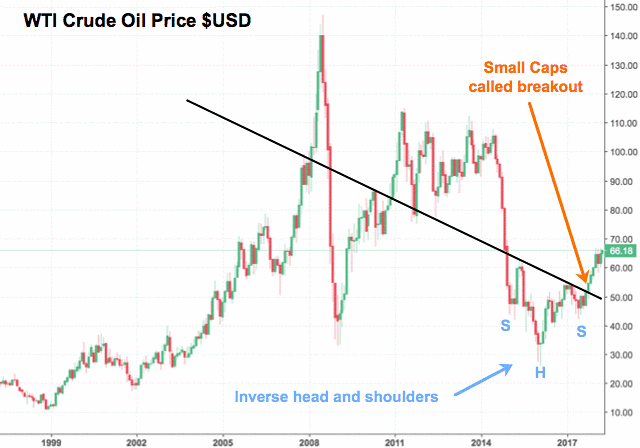Oil markets brace for volatility ahead

News of geopolitical unrest in the Middle East has shaken up the oil market once again. Oil prices have risen by around 6% this week since news broke of an alleged chemical attack on civilians in Syria.
West Texas Intermediate (WTI) crude futures were trading at two-week highs while Brent crude hit its uppermost level since 2014. Over the past few days, the price of crude oil for May delivery has risen sharply from US$62 per barrel to US$65/bbl.
As Small Caps reported in November last year, oil prices have been threatening to breakout from around US$54/bbl and many oil market participants fear the latest unrest in Syria could provide the spark for this to occur.

According to Bloomberg, Saudi Arabia is looking for oil to hit US$80/bbl as the ideal backdrop for the largest IPO in history. Saudi Aramco is currently the world’s largest oil company and is expected to be valued at around US$1-2 trillion when it lists on the Saudi domestic stock market.
The contrarian view
With details and facts from Syria still sketchy at best, the truth of the matter has not deterred a good story from doing the rounds.
Political angst is currently sweeping across the US, the UK and Europe, with political leaders from across the G20 denouncing Russian aggression including US President Donald Trump, British Prime Minister Theresa May and French President Emmanuel Macron.
As was the case with similar allegations back in 2012 and 2016 (dastardly chemical attacks organised by the Assad regime), a NATO-led consensus has quickly resulted in sabre-rattling among the power-mongers at the UN with military action seemingly on the cards.
The oil market has reacted with risk-aversion, much like in 2012 and 2016. The threat of restricted oil supplies, in addition to the disruption of key trade routes, has led to a spike in oil prices and market participants fear there is more to come.
If looking at 2012 and 2016, the allegations of Syrian aggression were never proved and/or followed up with military action, which led to oil prices reverting back to their fundamental demand and supply factors, as opposed to sentiment-led panic buying.
On this occasion in 2018, Middle East unrest comes at a time when oil prices are trending higher having hammered out a base of US$40/bbl since late 2016. Recent news of a boost in inventories had the effect of capping price gains but this factor has now been removed from traders’ minds as futures markets price in the threat of geopolitical unrest in Syria.
Looking back to the future
It’s worth mentioning that since 2011, Syria has been ravaged by foreign intervention and internal civil war.
More than 250,000 Syrians have lost their lives in four-and-a-half years of armed conflict, which began with anti-government protests before escalating into a full-scale civil war.
Syria has also seen more than 11 million of its citizens (30% of its population) displaced leading to extensive socio-economic impacts across Europe and Asia.
Over that time, oil supplies were not disrupted, and oil prices were responding to entirely different factors — such as the large production rates coming out the US and OPEC production adjustments.
Since the devastation in Syria began in 2011, oil prices have actually fallen from around US$120/bbl to a low of US$40/bbl in 2016.
Therefore, the recent spike in oil prices could potentially be yet another case of buying the rumour and selling the fact. Although, on the other hand, if the current war of words and threats escalates, there is a fair chance of further sentiment-driven buying.
Futures markets are currently forecasting a fall in oil prices with longer-dated contracts for delivery in 2019 currently trading at US$57-62/bbl, a touch lower than the May-2018 price of around US$65/bbl.
With all that in mind, keep your attention focused on developments at the UN war council (as well as production rates from the world’s largest oil producers) because oil is in for a volatile few days and weeks.
